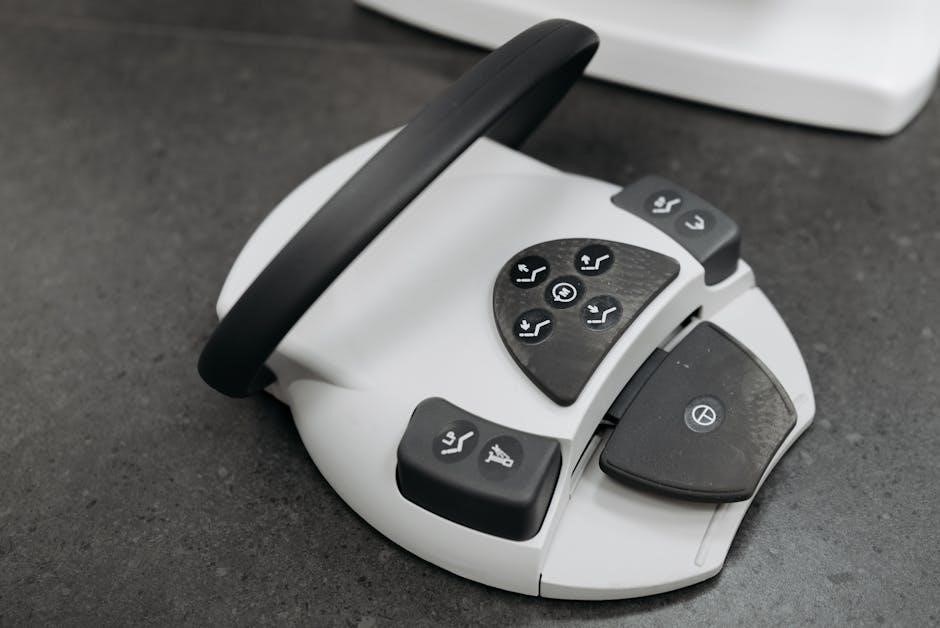Toshiba Aircon Remote Control Manual: A Comprehensive Guide
This comprehensive guide provides an overview of Toshiba air conditioner remote control manuals. It helps users understand the functions, settings, and troubleshooting tips. This ensures optimal use and maintenance of their Toshiba air conditioning units, guaranteeing user satisfaction.
Toshiba air conditioner remote controls are essential tools for managing your indoor climate, offering convenient operation of your AC unit; These devices allow users to adjust temperature, fan speed, and mode settings from a distance, enhancing comfort and energy efficiency. Understanding the basic functions of your Toshiba remote control is the first step in optimizing your air conditioning experience.
These remotes often come equipped with advanced features such as timer settings and air direction control, offering personalized comfort. Familiarizing yourself with the remote’s layout and functionalities ensures you can easily adapt your cooling or heating preferences. Additionally, knowing how to troubleshoot common issues can save time and prevent unnecessary service calls.
Toshiba remote controls are designed for ease of use, but consulting the owner’s manual is crucial for unlocking their full potential. This guide serves as a starting point for navigating the various functions and settings available on your Toshiba air conditioner remote.
Importance of the Owner’s Manual
The owner’s manual for your Toshiba air conditioner remote control is a vital resource that should never be overlooked. It provides detailed instructions on how to properly operate your remote and maximize the performance of your AC unit. Inside, you’ll find explanations of each button and function, ensuring you understand how to adjust settings to your preferences.
The manual also includes troubleshooting tips for common issues, helping you resolve problems quickly without needing professional assistance. Furthermore, it contains safety information and precautions to prevent accidents and ensure the longevity of your device. By consulting the owner’s manual, you can avoid misuse and maintain your Toshiba air conditioner in optimal condition.
Ignoring the manual could lead to incorrect operation, potentially damaging your unit or reducing its efficiency. Therefore, taking the time to read and understand the owner’s manual is essential for every Toshiba air conditioner owner.
Finding Your Specific Toshiba Remote Control Manual

Locating the correct manual for your Toshiba air conditioner remote control is crucial for effective operation and troubleshooting. Start by checking the documentation that came with your air conditioning unit. The manual for the remote is often included in the same package. If you can’t find a physical copy, don’t worry; digital versions are readily available.
Visit the official Toshiba website and navigate to the support section. Here, you can search for manuals by entering the model number of your remote or air conditioner. The model number is usually printed on the remote itself or on the indoor unit. Numerous third-party websites also host a wide range of Toshiba manuals.

Websites dedicated to manuals can be excellent resources. Remember to verify the manual’s authenticity and ensure it matches your specific model. Having the correct manual ensures you have accurate instructions for setup, operation, and maintenance.
Online Resources for Manuals
Finding your Toshiba air conditioner remote control manual online is straightforward, thanks to numerous resources. Toshiba’s official website is the primary and most reliable source. Navigate to their support section, where you can search using your model number to find the specific manual for your device.
Websites like ManualsLib offer extensive databases of user manuals, including many Toshiba models. These sites often allow you to view the manual directly or download it for offline access. Always ensure the manual you download matches your exact model number to avoid incorrect instructions.
Also, consider searching online retailers or forums dedicated to air conditioning systems. These platforms sometimes host user-uploaded manuals or provide links to official documentation. By using a combination of these resources, you can quickly locate the manual you need.
Model Number Identification
Locating the model number of your Toshiba air conditioner remote control is crucial for finding the correct manual. The model number is typically printed on the device itself. Check the back, inside the battery compartment, or on the front panel.
It may be a combination of letters and numbers, such as RBC-AX31U or CT-8002. This identifier is unique to your specific remote control model. If you can’t find it on the remote, consult your air conditioner’s indoor unit or the original purchase documents.
The model number ensures you access the appropriate manual with accurate instructions and troubleshooting guidance. Using the wrong manual can lead to incorrect settings and potential damage. With the correct model number, finding the right manual online becomes a simple task.
Understanding Basic Remote Control Functions
Familiarizing yourself with the basic functions of your Toshiba air conditioner remote control is the first step to efficient operation. The most common functions include the power button, mode selection, temperature adjustment, and fan speed control.
The power button turns the air conditioner on and off. Mode selection allows you to choose between cooling, heating, fan, or auto modes. Temperature adjustment buttons increase or decrease the desired room temperature. Fan speed control regulates the airflow, offering options like low, medium, high, or auto.
These basic features allow you to set your desired comfort level. Knowing how to use them effectively can help you manage the energy consumption and overall performance of your Toshiba air conditioner. Always refer to your specific model’s manual for precise instructions.
Power Button and Mode Selection
The power button is the most fundamental control, initiating or terminating the air conditioner’s operation. A single press typically activates the unit, while another press deactivates it. Understanding the mode selection function is equally important, allowing you to tailor the air conditioner’s operation to your specific needs.
Common modes include “Cool” for cooling the room, “Heat” for warming the room (if your unit supports it), “Fan” for air circulation without cooling or heating, and “Auto” for allowing the air conditioner to automatically adjust settings based on the room temperature.
Selecting the appropriate mode optimizes energy efficiency and comfort. Consult your Toshiba air conditioner remote control manual for detailed explanations of each mode and their respective energy consumption levels.
Temperature Adjustment
The temperature adjustment feature is a cornerstone of air conditioner control, allowing users to personalize their comfort levels. Typically, dedicated “up” and “down” buttons are used to increase or decrease the desired room temperature. Each press adjusts the temperature by a degree Celsius or Fahrenheit, depending on the unit’s settings.
The remote control displays the set temperature, providing visual feedback. Consult your Toshiba air conditioner remote control manual to understand the temperature range supported by your specific model. It is important to note that setting an extremely low temperature in cooling mode, or a high temperature in heating mode, can lead to increased energy consumption.
Optimal temperature settings vary based on personal preference and ambient conditions. Experiment to find your ideal balance of comfort and energy efficiency.
Fan Speed Control
The fan speed control function on your Toshiba air conditioner remote allows you to adjust the intensity of the airflow produced by the unit. Common fan speed settings include “Auto,” “Low,” “Medium,” and “High,” providing varying degrees of cooling or heating power and noise levels.
The “Auto” mode automatically selects the fan speed based on the current room temperature and the set temperature. This mode optimizes energy efficiency and maintains a consistent comfort level. Lower fan speeds offer quieter operation, ideal for nighttime use or situations where minimal noise is preferred. Higher fan speeds provide more rapid cooling or heating, quickly reaching the desired temperature.
Refer to your Toshiba air conditioner remote control manual for specific details on the available fan speed settings and their corresponding effects on airflow and energy consumption.
Advanced Features and Settings
Toshiba air conditioner remotes often include advanced features beyond basic temperature and fan control. These settings allow for a customized and energy-efficient cooling experience. Understanding these options enhances user comfort and optimizes the air conditioner’s performance.
Advanced features may include timer settings for scheduled operation, enabling automatic start and stop times. Air direction adjustment allows users to control the airflow direction for optimal comfort within the room. Some models also offer specialized modes such as “Sleep” or “Eco” which are designed to conserve energy and enhance user comfort during specific conditions.
Consult your Toshiba air conditioner remote control manual for detailed instructions on utilizing these advanced features and tailoring them to your specific needs. Proper understanding ensures effective use and maximizes the benefits.
Timer Settings and Scheduled Operations
Toshiba air conditioner remotes provide timer settings for scheduled operation, enabling users to automate their cooling needs. This feature allows you to set specific times for the air conditioner to turn on or off, providing convenience and energy savings.
To set the timer, consult your Toshiba remote control manual for detailed instructions. Typically, you can program the air conditioner to start cooling before you arrive home or shut off automatically at night. Some remotes offer daily or weekly scheduling options for even greater flexibility.

Properly configuring the timer settings ensures that your air conditioner operates only when needed, reducing energy consumption and lowering your electricity bills. Refer to your manual for model-specific instructions and advanced timer features.
Air Direction Adjustment
Adjusting the air direction on your Toshiba air conditioner is essential for achieving optimal comfort. The remote control allows you to modify both the horizontal and vertical airflow, ensuring that cool or warm air is distributed evenly throughout the room.
Refer to your Toshiba remote control manual for specific instructions on using the air direction buttons. These buttons typically control the swing and louver functions, enabling you to set the airflow pattern according to your preferences. You can often choose from fixed positions or allow the louvers to swing automatically.
Proper air direction adjustment prevents hot or cold spots, creating a more comfortable and consistent indoor environment. Experiment with different settings to find the airflow pattern that best suits your needs and room layout, as detailed in your manual.
Troubleshooting Common Issues
Encountering issues with your Toshiba air conditioner remote control can be frustrating, but many problems can be resolved with simple troubleshooting steps. Begin by checking the batteries; ensure they are correctly installed and have sufficient power. If the remote is unresponsive, try replacing the batteries with new ones.
Another common issue is a blocked signal path. Make sure there are no obstructions between the remote control and the air conditioner unit. Clean the remote’s infrared transmitter and the receiver on the unit with a soft, dry cloth.
If the air conditioner still doesn’t respond, consult your Toshiba remote control manual for specific troubleshooting instructions. It may provide solutions for error codes or other operational problems. Resetting the remote to its default settings can also resolve some issues, as detailed in the manual.
Battery Replacement and Maintenance

Maintaining your Toshiba air conditioner remote control ensures its longevity and reliable performance. Proper battery replacement is crucial; always use the correct type of batteries, typically AAA, as specified in your remote control manual. Replace batteries when the remote’s display dims or becomes unresponsive.

When replacing batteries, ensure correct polarity (+/-) alignment. Remove the old batteries carefully to prevent any leakage, which can damage the remote. If you won’t be using the remote for an extended period, remove the batteries to prevent corrosion.

Clean the remote control regularly with a soft, dry cloth to remove dust and grime. Avoid using harsh chemicals or solvents. Store the remote in a cool, dry place away from direct sunlight. Following these maintenance steps will keep your remote in optimal condition.
Remote Control Setup and Configuration
Setting up your Toshiba air conditioner remote control correctly is essential for seamless operation. Begin by inserting batteries, ensuring proper polarity. The remote usually comes with default settings pre-configured from the factory, which often suit standard usage.
For initial setup, consult your manual for specific model instructions. If you have multiple indoor units, address matching might be necessary. This process involves setting a unique identifier for each remote to control individual units without interference. Some models feature a Remote Control B setup.
This may require pressing a reset button on the indoor unit and then configuring the remote accordingly. Refer to the manual for detailed steps on Remote Control B setup. Proper configuration guarantees efficient control over your air conditioning system.
Initial Setup and Default Settings
Upon receiving your Toshiba air conditioner remote, the initial setup is crucial for proper functionality. Begin by inserting fresh batteries, typically AAA, ensuring correct polarity as indicated inside the battery compartment. The remote usually operates with default settings established at the factory.
These default settings often include a standard temperature mode and fan speed. To initiate the setup, point the remote towards the air conditioning unit and press the power button. The unit should respond, indicating successful pairing.
Consult the owner’s manual for specific model instructions, as button layouts and functions can vary. Some remotes may require a reset by pressing a small recessed button, typically using a pen or similar object. This ensures the remote syncs correctly with the air conditioner using the default parameters.
Remote Control B Setup (if applicable)
Some Toshiba air conditioning systems support two remote controls, designated A and B. If your system includes a second remote, setting up Remote Control B requires a specific procedure. First, ensure the air conditioning unit is powered on, often achieved by pressing the reset button on the indoor unit.
Next, point Remote Control B towards the indoor unit and press a designated button, possibly labeled “SET” or requiring a combination of button presses as outlined in the owner’s manual. This action initiates the pairing process, linking Remote Control B to the system.

The manual may instruct you to change a setting using a wired remote controller before using the wireless remote. Follow the manual’s instructions precisely to ensure proper communication and avoid conflicts between the two remote controls. Successful setup will enable independent control from Remote Control B.

Address Matching for Multiple Units
In installations with multiple Toshiba air conditioning units, particularly in commercial settings, address matching is crucial. This process ensures that each remote control operates only its intended unit, preventing unintended operation of other systems within the vicinity. The address matching procedure typically involves setting a unique code on both the remote control and the corresponding indoor unit.
Consult the owner’s manual for specific instructions, as the method varies between models. This might involve accessing a hidden menu on the remote or manipulating dip switches on the indoor unit’s control board. Incorrect address settings can lead to operational confusion, with a single remote affecting multiple units simultaneously.
Carefully follow the manual’s guidance to assign distinct addresses to each air conditioner and its dedicated remote. This ensures precise and independent control over each zone or room, optimizing comfort and energy efficiency. Documenting the assigned addresses can simplify future maintenance or troubleshooting.
Error Codes and Troubleshooting
Toshiba air conditioners often display error codes on the remote control or the unit itself to indicate malfunctions. Consulting the owner’s manual is crucial for identifying the specific problem associated with each code. These codes can range from simple issues like sensor failures or refrigerant leaks to more complex problems involving the compressor or electronic control board.
The manual provides detailed explanations of each error code, along with recommended troubleshooting steps. For minor issues, users might be able to resolve the problem themselves by resetting the unit or checking connections. However, more serious problems typically require the expertise of a qualified HVAC technician.
Attempting to repair complex issues without proper training can be dangerous and may void the warranty. Before contacting a technician, gather information about the error code and the unit’s model number. This will help the technician diagnose the problem more quickly and efficiently, saving time and repair costs.
Safety Information and Precautions
The Toshiba air conditioner remote control manual includes vital safety information and precautions to ensure user safety and prevent damage to the unit. Users should never attempt to install or repair the air conditioner themselves, as this can lead to electric shock or other hazards. Always consult a qualified technician for installation and maintenance.
Ensure that the air conditioner is properly grounded and that the power supply matches the unit’s specifications. Avoid using the air conditioner in environments with flammable gases or liquids. Regularly clean the air filters to prevent dust accumulation and maintain optimal performance. Do not expose the remote control to water or extreme temperatures.

When replacing batteries in the remote control, use the correct type and dispose of old batteries properly. If the air conditioner malfunctions, immediately turn it off and disconnect it from the power supply. Contact Toshiba support or a certified technician for assistance. Ignoring safety precautions can result in serious injury or property damage.
Contacting Toshiba Support
If you encounter any issues with your Toshiba air conditioner remote control or the unit itself, contacting Toshiba Support is a crucial step for resolving problems efficiently. Before reaching out, gather essential information such as the model number of your air conditioner and the remote control. Note down any error codes displayed on the unit or remote.
Visit the official Toshiba website to find the support section, where you can access FAQs, troubleshooting guides, and contact information. You may find answers to common questions or solutions to simple issues. If you require further assistance, locate the customer service phone number or email address for your region.
When contacting support, clearly explain the problem you are experiencing and provide all the relevant details you collected. Be prepared to answer questions about your unit’s configuration and usage. Following these steps will help Toshiba Support diagnose the issue and provide the best possible solution.
